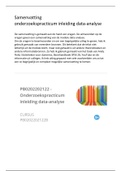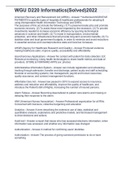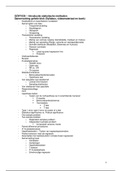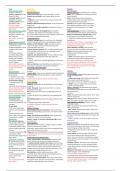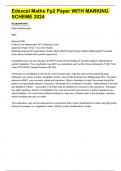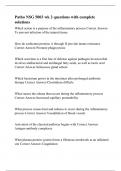Summary cell growth & differentiation core
fundamental
1
,Chapter 1 introduction to cancer mechanisms
Molecular mechanisms of cancer
Many of our knowledge of cancer mechanisms started by studying oncogenic viruses
• DNA integration: destroy/downregulate tumour suppressor genes or upregulate proto-oncogenes
• Viruses also make proteins that downregulate cell-cycle control genes → to facilitate viral genome
replication
Cancer cell types are named according to the tissue from which they originate and what mutation causes it.
Generally, cancer is a deviation from homeostasis and is thus caused by either three deviations from it:
• Upregulation of division
• Downregulation of apoptosis
• Blocked differentiation
− Progenitor cells become transiently amplifying cells → many treatments target the division of the
cell, therefore these cancer types are especially hard to treat
− Often found in leukaemia
Each of these three phenomena leads to cancer development,
which progresses in different subsequential stages:
1. Initiation → elimination is at this state still relatively often
occurring as many neo-epitopes do not mutate so
frequently at this point, at later stages cancers often
escape
2. Progression
3. Evasion → or elimination by the immune system
➔ Growth and angiogenesis
4. Invasion of surrounding tissues
5. Metastasis
➔ Growth and angiogenesis
Cancer development is a multi-hit model: many mutations accumulate that then together lead to cancer
• Driver mutations: directly contribute to the transformation of cells into cancer cells → can serve a role as
clonal markers: mutation to see if two cells are “clonal” = related
− Driver mutations can work synergistically: they aggravate each other e.g.
• Bystander mutations: do not directly contribute to the cell transformation but can aggravate the cancer
phenotype
• Genetic alterations in cancer cells require the DNA repair mechanisms to be less functional → these
increase the chance of acquiring mutations
− Cancer pre-disposition syndrome is a syndrome in which people have hereditary mutation(s) in DNA
repair genes
As people age, mutations accumulate → ageing increases the chance of malignant, activating mutations to occur →
on a population basis, cancer occurs more often amongst the elderly.
Multiple mutations take place before a mutated cell can acquire all hallmarks of a cancer cell and produce a
malignant tumour. Therefore, cancer is described by a multi-hit model. The chance of such carcinogenic hits
increases with:
• time, ageing → longer subjection to environmental factors
• number of clonal replications → occurs very often in cancer cells: high chance of acquiring a mutation or an
epigenetic change that disables DNA repair and surveillance mechanisms → genome instability increase
2
,Hallmarks of cancer
Cancer cells are different from healthy cells. The differences in
the cell functioning that cause the cell to behave as a cancer cell
are called the hallmarks of cancer.
• sustaining proliferative signalling: in the absence of
growth factors, cells remain in the G0 phase (quiescent).
However cancer cells cause constitutive signalling for
entrance of the G1 and subsequent cell cycle events.
• evading growth suppressors: is the circumvention of
processes that downregulate the cell cycle:
- inhibiting growth factors (TGFβ)
- inducers (or promoters) of apoptosis
- suppressors for passage through the restriction point
• avoiding immune destruction: by downregulating the antigen presentation to CTLs and DCs, by inducing
Tregs and by promoting the production of immunoinhibitory cytokines.
• enabling replicative immortality: normal cells cannot replicate an infinite number of times because of
telomere erosion. In cancer cells, however, the telomerases (that are normally only active during embryonic
development) are reactivated. Therefore, the telomere length can in theory reach an infinity length,
therefore enabling infinite DNA replication and cell division.
• tumour-promoting inflammation: by promotion of M2 macrophage function by e.g. production of M2-
activity-stimulating cytokines (via the Th1 cells), by production of growth factors by immune cells, and by the
macrophages and immune cells producing ROS that further increase the mutational burden.
• activating invasion & metastasis: by the downregulation of proteins necessary for cell attachment to the
ECM, such as integrins and (E-)cadherins.
• inducing angiogenesis: by the production of angiogenic growth factors such as VEGF, the VEGFR and
hematopoietic precursors.
• gene instability & mutation: due to the decreased activity of DNA damage sensors and repair mechanisms
(as a strategy to evade growth suppression)
• resisting cell death: by resistance to apoptosis, either by inhibiting apoptosis or by lost oncogenic signal
surveillance.
• deregulating cellular energetics: cells shift from the slow, high energy yielding oxidative phosphorylation to
the Aerobic glycolysis, known as the Warburg effect. This allows for a fast energy supply for these rapidly
proliferating cells.
Genetic alterations in cancer
onset of cancer mainly due to mutation in three classes of genes:
• proto-oncogenes: mutation changes these genes into oncogenes/chromosomal aberration → product is
hypersecreted/hyperactive: gain-of-function mutations, almost always dominant
− cell cycle progression proteins/chemicals
o Point mutations: hyperactive
o Chromosomal translocation: chimeric proteins e.g. activator with self-phosphorylating
kinase domain or translocation behind an active promoter
3
, o Amplified DNA segment: gene is present several times more than in healthy individuals →
higher expression levels
• tumour-suppressor genes: mutation changes these genes to become non-functional → no
transcript/reduced transcription/non-functional transcript: loss-of-function mutations, always recessive
− apoptosis proteins, inhibitory proteins (of the cell cycle)
o Deletion
o Inactivating point-mutations
• genome maintenance genes: involved in maintaining the genome’s integrity, inactivation of these genes by
mutation causes the cell to tolerate genomic mutations because these are not reversed anymore as the
control mechanisms lack or are non-functional.
− DNA repair proteins
Multiple either environmental or internal factors can cause cancer, and we are constantly subject to these factors
→ constant DNA-repair needed
• Physical → radiation
• Chemical → radicals, PAHs
• Biological → Viruses (as explained earlier)
• Internal → (inborn) errors of repair mechanisms
These factors can lead to a large variety of genetic alterations that can cause cancer. These alterations often occur
at known locations in the genome, therefore they can be identified by panel sequencing or WES → if unknown
location: WGS
• Chromosome loss: (a part of) a whole chromosome is lost → Copy number variation (CNV)
• Translocation: a part of a chromosome is translocated → leads to altered gene function/regulation
− Gene broken
− Gene behind different regulatory element
− Gene-gene fusion → e.g. BCR-ABL
• Insertional mutagenesis
• (micro)INDELS
• (point) mutations
• Chromotrypsis
As a tumour cell accumulates more and more mutations over time (snowball effect) and the type and order of
changes does not matter to acquire the cancer hallmarks → there is large heterogeneity
• Within a tumour
• Between tumours
• Therefore it is hard to treat all tumours and a whole tumour with the same treatment → complicates
treatment
ssRNA-seq: Can aid to find differences in transcriptomic levels between individual cells within a tumour and to study
the influence of surroundings (and surrounding) (immune) cells
4
fundamental
1
,Chapter 1 introduction to cancer mechanisms
Molecular mechanisms of cancer
Many of our knowledge of cancer mechanisms started by studying oncogenic viruses
• DNA integration: destroy/downregulate tumour suppressor genes or upregulate proto-oncogenes
• Viruses also make proteins that downregulate cell-cycle control genes → to facilitate viral genome
replication
Cancer cell types are named according to the tissue from which they originate and what mutation causes it.
Generally, cancer is a deviation from homeostasis and is thus caused by either three deviations from it:
• Upregulation of division
• Downregulation of apoptosis
• Blocked differentiation
− Progenitor cells become transiently amplifying cells → many treatments target the division of the
cell, therefore these cancer types are especially hard to treat
− Often found in leukaemia
Each of these three phenomena leads to cancer development,
which progresses in different subsequential stages:
1. Initiation → elimination is at this state still relatively often
occurring as many neo-epitopes do not mutate so
frequently at this point, at later stages cancers often
escape
2. Progression
3. Evasion → or elimination by the immune system
➔ Growth and angiogenesis
4. Invasion of surrounding tissues
5. Metastasis
➔ Growth and angiogenesis
Cancer development is a multi-hit model: many mutations accumulate that then together lead to cancer
• Driver mutations: directly contribute to the transformation of cells into cancer cells → can serve a role as
clonal markers: mutation to see if two cells are “clonal” = related
− Driver mutations can work synergistically: they aggravate each other e.g.
• Bystander mutations: do not directly contribute to the cell transformation but can aggravate the cancer
phenotype
• Genetic alterations in cancer cells require the DNA repair mechanisms to be less functional → these
increase the chance of acquiring mutations
− Cancer pre-disposition syndrome is a syndrome in which people have hereditary mutation(s) in DNA
repair genes
As people age, mutations accumulate → ageing increases the chance of malignant, activating mutations to occur →
on a population basis, cancer occurs more often amongst the elderly.
Multiple mutations take place before a mutated cell can acquire all hallmarks of a cancer cell and produce a
malignant tumour. Therefore, cancer is described by a multi-hit model. The chance of such carcinogenic hits
increases with:
• time, ageing → longer subjection to environmental factors
• number of clonal replications → occurs very often in cancer cells: high chance of acquiring a mutation or an
epigenetic change that disables DNA repair and surveillance mechanisms → genome instability increase
2
,Hallmarks of cancer
Cancer cells are different from healthy cells. The differences in
the cell functioning that cause the cell to behave as a cancer cell
are called the hallmarks of cancer.
• sustaining proliferative signalling: in the absence of
growth factors, cells remain in the G0 phase (quiescent).
However cancer cells cause constitutive signalling for
entrance of the G1 and subsequent cell cycle events.
• evading growth suppressors: is the circumvention of
processes that downregulate the cell cycle:
- inhibiting growth factors (TGFβ)
- inducers (or promoters) of apoptosis
- suppressors for passage through the restriction point
• avoiding immune destruction: by downregulating the antigen presentation to CTLs and DCs, by inducing
Tregs and by promoting the production of immunoinhibitory cytokines.
• enabling replicative immortality: normal cells cannot replicate an infinite number of times because of
telomere erosion. In cancer cells, however, the telomerases (that are normally only active during embryonic
development) are reactivated. Therefore, the telomere length can in theory reach an infinity length,
therefore enabling infinite DNA replication and cell division.
• tumour-promoting inflammation: by promotion of M2 macrophage function by e.g. production of M2-
activity-stimulating cytokines (via the Th1 cells), by production of growth factors by immune cells, and by the
macrophages and immune cells producing ROS that further increase the mutational burden.
• activating invasion & metastasis: by the downregulation of proteins necessary for cell attachment to the
ECM, such as integrins and (E-)cadherins.
• inducing angiogenesis: by the production of angiogenic growth factors such as VEGF, the VEGFR and
hematopoietic precursors.
• gene instability & mutation: due to the decreased activity of DNA damage sensors and repair mechanisms
(as a strategy to evade growth suppression)
• resisting cell death: by resistance to apoptosis, either by inhibiting apoptosis or by lost oncogenic signal
surveillance.
• deregulating cellular energetics: cells shift from the slow, high energy yielding oxidative phosphorylation to
the Aerobic glycolysis, known as the Warburg effect. This allows for a fast energy supply for these rapidly
proliferating cells.
Genetic alterations in cancer
onset of cancer mainly due to mutation in three classes of genes:
• proto-oncogenes: mutation changes these genes into oncogenes/chromosomal aberration → product is
hypersecreted/hyperactive: gain-of-function mutations, almost always dominant
− cell cycle progression proteins/chemicals
o Point mutations: hyperactive
o Chromosomal translocation: chimeric proteins e.g. activator with self-phosphorylating
kinase domain or translocation behind an active promoter
3
, o Amplified DNA segment: gene is present several times more than in healthy individuals →
higher expression levels
• tumour-suppressor genes: mutation changes these genes to become non-functional → no
transcript/reduced transcription/non-functional transcript: loss-of-function mutations, always recessive
− apoptosis proteins, inhibitory proteins (of the cell cycle)
o Deletion
o Inactivating point-mutations
• genome maintenance genes: involved in maintaining the genome’s integrity, inactivation of these genes by
mutation causes the cell to tolerate genomic mutations because these are not reversed anymore as the
control mechanisms lack or are non-functional.
− DNA repair proteins
Multiple either environmental or internal factors can cause cancer, and we are constantly subject to these factors
→ constant DNA-repair needed
• Physical → radiation
• Chemical → radicals, PAHs
• Biological → Viruses (as explained earlier)
• Internal → (inborn) errors of repair mechanisms
These factors can lead to a large variety of genetic alterations that can cause cancer. These alterations often occur
at known locations in the genome, therefore they can be identified by panel sequencing or WES → if unknown
location: WGS
• Chromosome loss: (a part of) a whole chromosome is lost → Copy number variation (CNV)
• Translocation: a part of a chromosome is translocated → leads to altered gene function/regulation
− Gene broken
− Gene behind different regulatory element
− Gene-gene fusion → e.g. BCR-ABL
• Insertional mutagenesis
• (micro)INDELS
• (point) mutations
• Chromotrypsis
As a tumour cell accumulates more and more mutations over time (snowball effect) and the type and order of
changes does not matter to acquire the cancer hallmarks → there is large heterogeneity
• Within a tumour
• Between tumours
• Therefore it is hard to treat all tumours and a whole tumour with the same treatment → complicates
treatment
ssRNA-seq: Can aid to find differences in transcriptomic levels between individual cells within a tumour and to study
the influence of surroundings (and surrounding) (immune) cells
4

